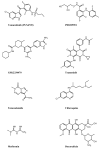The Therapeutic Potential of Pyroptosis in Melanoma
- PMID: 36674798
- PMCID: PMC9861152
- DOI: 10.3390/ijms24021285
The Therapeutic Potential of Pyroptosis in Melanoma
Abstract
Pyroptosis is a programmed cell death characterized by the rupture of the plasma membranes and release of cellular content leading to inflammatory reaction. Four cellular mechanisms inducing pyroptosis have been reported thus far, including the (i) caspase 1-mediated canonical, (ii) caspase 4/5/11-mediated non-canonical, (iii) caspase 3/8-mediated and (iv) caspase-independent pathways. Although discovered as a defense mechanism protecting cells from infections of intracellular pathogens, pyroptosis plays roles in tumor initiation, progression and metastasis of tumors, as well as in treatment response to antitumor drugs and, consequently, patient outcome. Pyroptosis induction following antitumor therapies has been reported in several tumor types, including lung, colorectal and gastric cancer, hepatocellular carcinoma and melanoma. This review provides an overview of the cellular pathways of pyroptosis and discusses the therapeutic potential of pyroptosis induction in cancer, particularly in melanoma.
Keywords: drug combinations; gasdermin; gene signature; melanoma; pyroptosis.
Conflict of interest statement
The authors declare no conflict of interest.
Figures



References
-
- Galluzzi L., Vitale I., Aaronson S.A., Abrams J.M., Adam D., Agostinis P., Alnemri E.S., Altucci L., Amelio I., Andrews D.W., et al. Molecular mechanisms of cell death: Recommendations of the Nomenclature Committee on Cell Death 2018. Cell Death Differ. 2018;25:486–541. doi: 10.1038/s41418-017-0012-4. - DOI - PMC - PubMed
Publication types
MeSH terms
Substances
LinkOut - more resources
Full Text Sources
Medical
Research Materials

